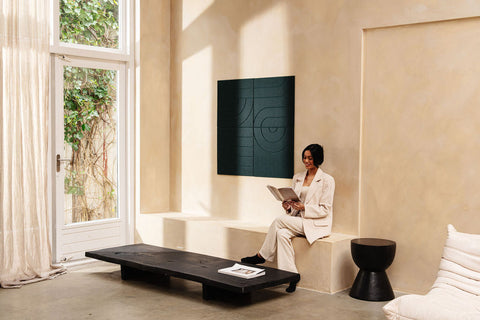We are often asked what is the difference between the wooden wall panels and the version made of felt. We are happy to inform you about it in the blog below!
1. Better Acoustic Properties.
-
fully felt panels:
felt panels 9 mm thick or more offer superior sound absorption because the entire surface of the panel can absorb and dampen sound. This makes them particularly effective for reducing reverberation and improving room acoustics. For consumers we supply in 9mm and for the business market we have up to 18mm including 4cm of polyester wool ourselves. That's 58mm of sound dampening material. -
Wood panels with felt:
With wood panels, sound is only absorbed by the felt behind the wooden structure. The wood itself reflects some of the sound, making the overall acoustic effect less efficient.
2. Sustainability and Environmental Friendliness
-
Full felt panels:
Felt panels are often made from recycled PET material, such as plastic bottles. This makes them a sustainable choice that helps reduce plastic waste. They are also recyclable at the end of their life cycle. -
Wood panels with felt:
Although wood is a natural material, cutting down trees requires a larger carbon footprint. The use of adhesives and finishes can further reduce durability. The MDF version widely available for sale today can actually expand on contact with water.
3. Lighter and Easier in Installation
-
Full felt panels:
Felt panels are lightweight and flexible, making installation easier and faster. They can be easily attached to walls or ceilings without heavy construction. The adhesive backing makes installation extremely easy and can be done by a do-it-yourselfer without tools. -
Wood panels with felt:
Wood panels are heavier and require sturdier installation. This makes installation more labor intensive and expensive. More surface area is required to achieve the same acoustic value. One compensates for this by working at height. Then it is often necessary to saw or cut which complicates the installation.
4. Flexibility in Design
-
Full felt panels:
Felt panels offer a wide range of design options. They come in a variety of colors, shapes and patterns, making them ideal for creative and unique interior applications. In addition, they can be easily cut to size without loss of functionality. -
Wood panels with felt:
The design of wood panels is limited by the wooden structure. Although variation in finish is possible, it offers less flexibility than full felt. Some people also get headaches from the striped design of the wooden slats. It will ultimately come down to personal taste.
5. Maintainability
-
Full felt panels:
Felt panels are easy to clean with a vacuum cleaner or damp cloth. They retain their appearance and acoustic performance without intensive maintenance. -
Wood panels with felt:
Wood requires regular maintenance, such as polishing or treating against moisture and wear. This increases time and cost in the long run.
6. Cost benefit
-
All-felt panels:
Because felt panels are made of a single material, they are often more affordable to manufacture and install. This makes them a cost-effective solution without compromising on quality. -
Wood panels with felt:
Wood panels tend to be more expensive because of the complexity of design and materials.
7. Safety
-
Full felt panels:
Our felt panels made of PET material are class B fire retardant, which contributes to the safety of the room. They can be placed in the home or office without any problem. -
Wood panels with felt:
Wood is naturally more combustible and requires special treatments to meet the same standards.
Conclusion
Felt panels offer distinct advantages over wood panels coated with felt. They are more efficient in soundproofing, more environmentally friendly, lighter, more flexible in design and easier to install. In addition, they offer excellent value for money, making them a smart choice for those who value both functionality and aesthetics.
With our felt panels, you not only choose high-quality acoustic solutions, but also contribute to a more sustainable world.



